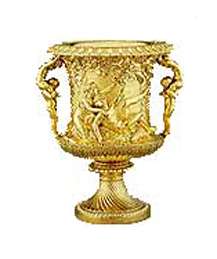Philip Rundell
Philip Rundell (1746–1827) was an English jeweller, known for his association with royalty, and the accumulation of a large business fortune.[1] With his partner John Bridge, he ran Rundell and Bridge, a firm with widespread interests in the jewellery and precious metal trades.[2]
Background
He was the son of Richard Rundell and his wife Ann Ditcher, he was born into a large family, and baptised at Norton St Philip, near Bath, Somerset.[1] His siblings included Francis Rundell the actor-manager,[3] a sister who married a Mr Harpur and was the mother of Elizabeth Bannister the actress,[3] Thomas Rundell of Bath the surgeon who married Maria Ketelby the writer,[3][4] and Elizabeth who married the mercer Thomas Bigge (the elder, died 1791).[5] His great-nephew Joseph Neeld, who inherited more than half his fortune, was grandson of Susannah Rundell who married John Bond.[6]
Business life

Rundell was apprenticed, and went into the London goldsmith's business Theed & Pickett. It became Pickett & Rundell in 1781. The firm had a major showroom at 32 Ludgate Hill, "at the sign of the Golden Salmon", in the period around 1768 to 1785. They retailed goods made by others such as John Emes.[7][8] They had manufacturing subsidiaries, one run by Benjamin Smith (and for some years Digby Scott) in Greenwich, and another by Paul Storr in Dean Street.[8][9]

Retirement, death and legacy
Philip Rundell withdrew capital from the firm in 1823.[10] He died in 1827, leaving a fortune that went off the probate scale, which stopped at £1,000,000. The residual estate, after bequests to the sum of £500,000, went to Joseph Neeld, about £800,000.[11]
Money left to the Bigge family was reported to have exceeded £100,000; according to James Losh, writing in his diary after news of the death, the bequests were some compensation for having had to put up with a "tyrannical miser".[12] The Gentleman's Magazine reported that Rundell, unmarried and without a home, liked to spend his time with his Brompton niece (i.e. Maria Bigge, who had married Thomas Bigge) or Elizabeth Bannister, another niece.[13]
Further reading
Hartop, Christopher, with foreword by HRH The Prince of Wales, introduction by Philippa Glanville and essays by Diana Scarisbrick, Charles Truman, David Watkin and Matthew Winterbottom (2005). Royal Goldsmiths: The Art of Rundell & Bridge 1797-1843 Cambridge: John Adamson ISBN 978-0-9524322-3-4
Notes
- 1 2 Culme, John. "Rundell, Philip". Oxford Dictionary of National Biography (online ed.). Oxford University Press. doi:10.1093/ref:odnb/37923. (Subscription or UK public library membership required.)
- ↑ "Rundell, Bridge & Rundell (Biographical details), British Museum - Term details". Retrieved 27 June 2015. horizontal tab character in
|title=at position 55 (help) - 1 2 3 Oxford Dictionary of National Biography (online ed.). Oxford University Press. (Subscription or UK public library membership required.)
- ↑ The Annual Biography and Obituary for the Year 1827. Longman, Hurst, Rees, Orme, and Brown. 1828. pp. 317–.
- ↑ John Hodgson; John Hodgson-Hinde (1832). A history of Northumberland, in three parts. Printed by E. Walker. p. 98.
- ↑ "Neeld, Joseph (1789–1856), of Grittleton House, nr. Chippenham, Wilts.; Kelston Park, Som., and 6 Grosvenor Square, Mdx., History of Parliament Online". Retrieved 27 June 2015.
- ↑ John A. Hyman (1 January 1994). Silver at Williamsburg: Drinking Vessels. Colonial Williamsburg. p. 69. ISBN 978-0-87935-125-0.
- 1 2 Philippa Glanville (5 November 2013). Silver in England. Taylor & Francis. p. 176. ISBN 978-1-136-61170-4.
- ↑ Sterling and Francine Clark Art Institute; Beth Carver Wees (1997). English, Irish, & Scottish Silver at the Sterling and Francine Clark Art Institute. Hudson Hills. p. 590. ISBN 978-1-55595-117-7.
- ↑ Gordon Campbell (9 November 2006). The Grove Encyclopedia of Decorative Arts. Oxford University Press. p. 301. ISBN 978-0-19-518948-3.
- ↑ John Britton; T. E. Jones (1850). Personal and literary memoir of the author.-pt. 2. Descriptive account of his literary works, by T. E. Jones.-pt. 3. (Appendix) Biographical,topographical, critical and miscellaneous essays. p. 314.
- ↑ James Losh (1963). The Diaries and Correspondence of James Losh. 2. Published for the Surtees Society by Andrews & Co. pp. 47–8.
- ↑ Gentleman's Magazine and Historical Review. 1827. p. 563.